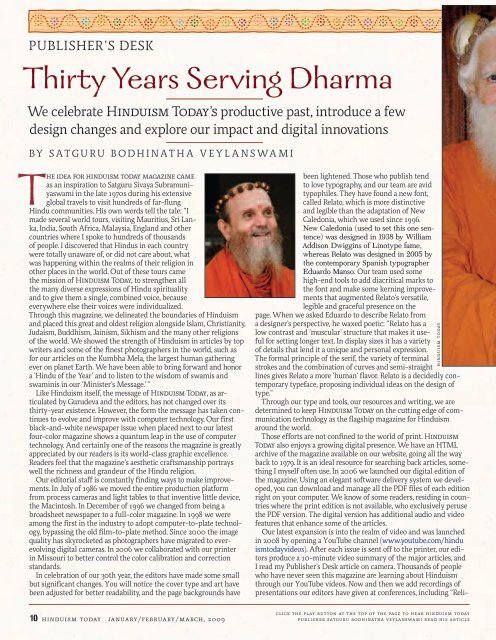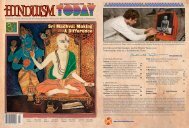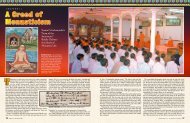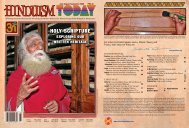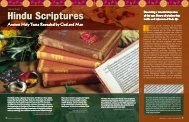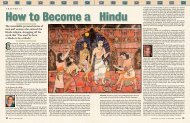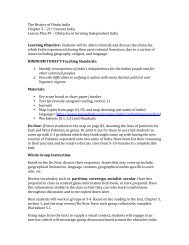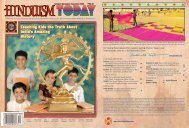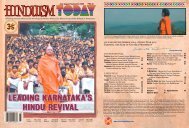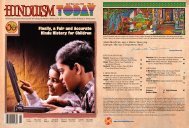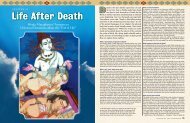Hinduism Today January 2009 - Cover, Index, Front Articles
Hinduism Today January 2009 - Cover, Index, Front Articles
Hinduism Today January 2009 - Cover, Index, Front Articles
You also want an ePaper? Increase the reach of your titles
YUMPU automatically turns print PDFs into web optimized ePapers that Google loves.
Publisher’s deskThirty Years Serving DharmaWe celebrate <strong>Hinduism</strong> <strong>Today</strong>’s productive past, introduce a fewdesign changes and explore our impact and digital innovationsby satguru bodhinatha veylanswamiThe idea for hinduism today magazine cameas an inspiration to Satguru Sivaya Subramuniyaswamiin the late 1970s during his extensiveglobal travels to visit hundreds of far-flungHindu communities. His own words tell the tale: “Imade several world tours, visiting Mauritius, Sri Lanka,India, South Africa, Malaysia, England and othercountries where I spoke to hundreds of thousandsof people. I discovered that Hindus in each countrywere totally unaware of, or did not care about, whatwas happening within the realms of their religion inother places in the world. Out of these tours camethe mission of <strong>Hinduism</strong> <strong>Today</strong>, to strengthen allthe many diverse expressions of Hindu spiritualityand to give them a single, combined voice, becauseeverywhere else their voices were individualized.Through this magazine, we delineated the boundaries of <strong>Hinduism</strong>and placed this great and oldest religion alongside Islam, Christianity,Judaism, Buddhism, Jainism, Sikhism and the many other religionsof the world. We showed the strength of <strong>Hinduism</strong> in articles by topwriters and some of the finest photographers in the world, such asfor our articles on the Kumbha Mela, the largest human gatheringever on planet Earth. We have been able to bring forward and honora ‘Hindu of the Year’ and to listen to the wisdom of swamis andswaminis in our ‘Minister’s Message.’ ”Like <strong>Hinduism</strong> itself, the message of <strong>Hinduism</strong> <strong>Today</strong>, as articulatedby Gurudeva and the editors, has not changed over itsthirty-year existence. However, the form the message has taken continuesto evolve and improve with computer technology. Our firstblack-and-white newspaper issue when placed next to our latestfour-color magazine shows a quantum leap in the use of computertechnology. And certainly one of the reasons the magazine is greatlyappreciated by our readers is its world-class graphic excellence.Readers feel that the magazine’s aesthetic craftsmanship portrayswell the richness and grandeur of the Hindu religion.Our editorial staff is constantly finding ways to make improvements.In July of 1986 we moved the entire production platformfrom process cameras and light tables to that inventive little device,the Macintosh. In December of 1996 we changed from being abroadsheet newspaper to a full-color magazine. In 1998 we wereamong the first in the industry to adopt computer-to-plate technology,bypassing the old film-to-plate method. Since 2000 the imagequality has skyrocketed as photographers have migrated to everevolvingdigital cameras. In 2006 we collaborated with our printerin Missouri to better control the color calibration and correctionstandards.In celebration of our 30th year, the editors have made some smallbut significant changes. You will notice the cover type and art havebeen adjusted for better readability, and the page backgrounds havebeen lightened. Those who publish tendto love typography, and our team are avidtypophiles. They have found a new font,called Relato, which is more distinctiveand legible than the adaptation of NewCaledonia, which we used since 1996.New Caledonia (used to set this one sentence)was designed in 1938 by WilliamAddison Dwiggins of Linotype fame,whereas Relato was designed in 2005 bythe contemporary Spanish typographerEduardo Manso. Our team used somehigh-end tools to add diacritical marks tothe font and make some kerning improvementsthat augmented Relato’s versatile,legible and graceful presence on thepage. When we asked Eduardo to describe Relato froma designer’s perspective, he waxed poetic: “Relato has alow contrast and ‘muscular’ structure that makes it usefulfor setting longer text. In display sizes it has a varietyof details that lend it a unique and personal expression.The formal principle of the serif, the variety of terminalstrokes and the combination of curves and semi-straightlines gives Relato a more ‘human’ flavor. Relato is a decidedly contemporarytypeface, proposing individual ideas on the design oftype.“Through our type and tools, our resources and writing, we aredetermined to keep <strong>Hinduism</strong> <strong>Today</strong> on the cutting edge of communicationtechnology as the flagship magazine for <strong>Hinduism</strong>around the world.Those efforts are not confined to the world of print. <strong>Hinduism</strong><strong>Today</strong> also enjoys a growing digital presence. We have an HTMLarchive of the magazine available on our website, going all the wayback to 1979. It is an ideal resource for searching back articles, somethingI myself often use. In 2006 we launched our digital edition ofthe magazine. Using an elegant software delivery system we developed,you can download and manage all the PDF files of each editionright on your computer. We know of some readers, residing in countrieswhere the print edition is not available, who exclusively perusethe PDF version. The digital version has additional audio and videofeatures that enhance some of the articles.Our latest expansion is into the realm of video and was launchedin 2008 by opening a YouTube channel (www.youtube.com/hinduismtodayvideos). After each issue is sent off to the printer, our editorsproduce a 10-minute video summary of the major articles, andI read my Publisher’s Desk article on camera. Thousands of peoplewho have never seen this magazine are learning about <strong>Hinduism</strong>through our YouTube videos. Now and then we add recordings ofpresentations our editors have given at conferences, including “Reli-hinduism todaygion and the Media” and “The California Textbook Controversy.” Weproduced our first major video in 2007, a three-part documentaryon the amazing Thai Pusam festival in Malaysia. It still holds therecord for the most views among our YouTube postings.To extend the distribution of <strong>Hinduism</strong> <strong>Today</strong>’s content, we printextra copies of key Educational Insight sections as 16-page bookletsthat can be purchased online and easily used in Hindu religiousclasses. One of the most popular is “Ten Questions People AskAbout <strong>Hinduism</strong>.” Back in the spring of 1990, a group of teens fromChicago sent a request to <strong>Hinduism</strong> <strong>Today</strong> for “official answers” tonine questions they were commonly asked by their peers. Thesequestions had perplexed the youth themselves; and their parentshad no convincing answers. <strong>Hinduism</strong> <strong>Today</strong> founder Gurudevatook up the challenge and composed thoughtful answers to the ninequestions. In 2004 we added a tenth dialog on caste, since that isthe most relentless criticism <strong>Hinduism</strong> faces today. In the questionand-answersession of lectures I give, one or more of these questionsis inevitably asked, which shows that the answers provided in thisbooklet continue to be useful.In 2004 quite a furor developed around the California State Boardof Education’s questionable approval of material on <strong>Hinduism</strong> for itssixth grade social studies textbook. The controversy still continuesin the form of an active lawsuit. Our own response to the matterwas to research, design and write a model 16-page lesson on Hinduhistory, beliefs and practices for sixth graders, written from theHindu point of view. It is historically sound, having been reviewedReaching out: Satguru Sivaya Subramuniyaswami in 2000 holdingthe magazine he founded to connect Hindus dispersed aroundthe world, to give them a shared global identity, to dispel the manymyths and misconceptions and to bring pride of place to the faithby prominent Hindu historians, and acceptable in content and toneto the various denominations of the global Hindu community. It, ofcourse, is a popular educational booklet with a distribution to date ofsome 35,000 copies. The first lesson covers the period from ancienttimes to 300ce. Lesson two of this series, published in the Oct/Nov/Dec, 2008, issue, covers the period 300 to 1100ce. Additional lessonsare planned over the next few years. This is an important way thatthe editorial staff is reaching out to the broader community, bothHindu and non-Hindu, to present an authentic view of <strong>Hinduism</strong>that will be understood and appreciated in the West.An inspiration came to me in 2007 to create a book out of <strong>Hinduism</strong><strong>Today</strong>. Specifically, I envisioned the best of our EducationalInsight sections compiled into a book called What Is <strong>Hinduism</strong>?Approached from scratch, such a book would take a large team yearsto produce, especially with the level of artistry, research, patienceand care that is found in each chapter. The serendipitous beauty ofthe project was that the necessary thousands of hours of loving attentionhad already gone into researching and designing its chaptersover the last ten years by our talented team of writers, editors andphotographers. All that was needed then, in 2007, was to gather thebest features and assemble them in a way that offers a thorough yethighly readable introduction to <strong>Hinduism</strong>. Voilà! In all, 46 EducationalInsights comprise the book and create a user-friendly way toread them versus a pile of 46 magazines!The book What Is <strong>Hinduism</strong>? has been introduced to Hindusthrough dozens of my lectures, highlighting the book’s rich graphicsand clear presentations. Thousands have attended these seminarsover these last two years. The book has also been successfully usedat major Hindu summer camps. The students can take the bookhome with them and continue to refer to it, helping them rememberthe teachings over the subsequent months. It is yet another way themagazine is impacting <strong>Hinduism</strong>.<strong>Hinduism</strong> <strong>Today</strong> has become a resource for mainstream America,a place where people can find authentic and reliable informationon Sanatana Dharma, and our editorial team is often called upon forhard-to-find answers to questions that few other institutions seeminclined to take the time to address. Harvard University is engagedin a CD-based Pluralism Project which teaches high school childrenabout other cultures and religions. Prof. Diana Eck, head of Harvard’sreligion department, invited <strong>Hinduism</strong> <strong>Today</strong> to participatein the Hindu expressions. In 1997 the former editor of Christianity<strong>Today</strong>, Terry Muck, invited us to collaborate on a chapter of his newDoubleday book, A Guide to Religions in America.We often get calls from religion editors in America, and was laudedas a solid source of Indian spirituality in a book published by JohnDart of the Los Angeles Times called Deities and Deadlines. TimeMagazine called years back to verify a story on Deepak Chopra’sphenomenal success. Indeed, <strong>Hinduism</strong> <strong>Today</strong> has gained a reputationfor credibility, access to authentic information and a commitmentto objective, unexaggerated reporting.But that’s just the beginning and doesn’t explain why a selectcommittee seeking the Hindu view on the ethics of human cloningfor a report to US President Bill Clinton called our editorial officesin March of 1997 or why the Ford Foundation sponsored two of oureditors to join fifty prominent religion editors in the US at a meetingin Atlanta, Georgia, or why we were asked to write a chapter onHindu medical ethics for the Southern Texas Medical Association...you get the idea; as interesting as our past has been, we think thefuture is going to prove even more remarkable.c l i c k t h e p l ay b u t t on at t h e t o p o f t h e pag e t o h e a r h i n d u i s m t o day10 hinduism today january/february/march, <strong>2009</strong> publisher satguru bodhinatha veylanswami read his articlejanuary/february/march, <strong>2009</strong> hinduism today 11


